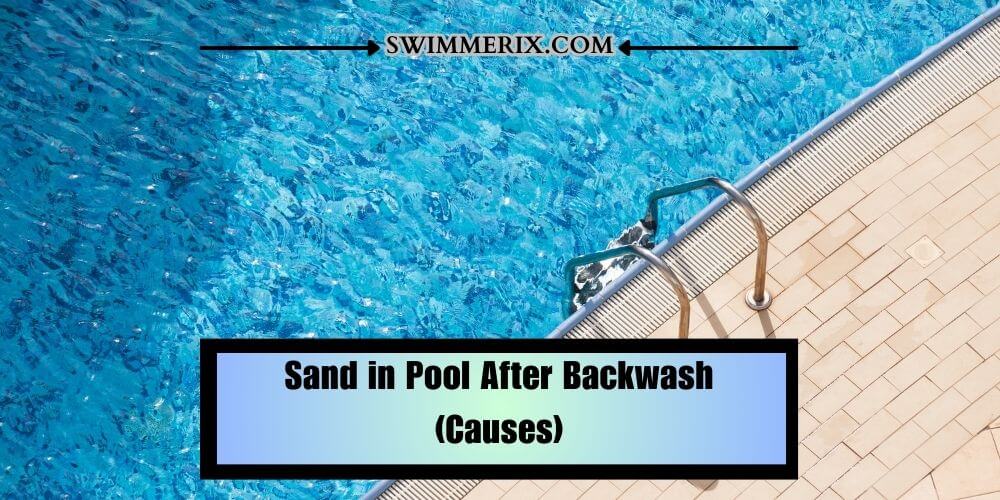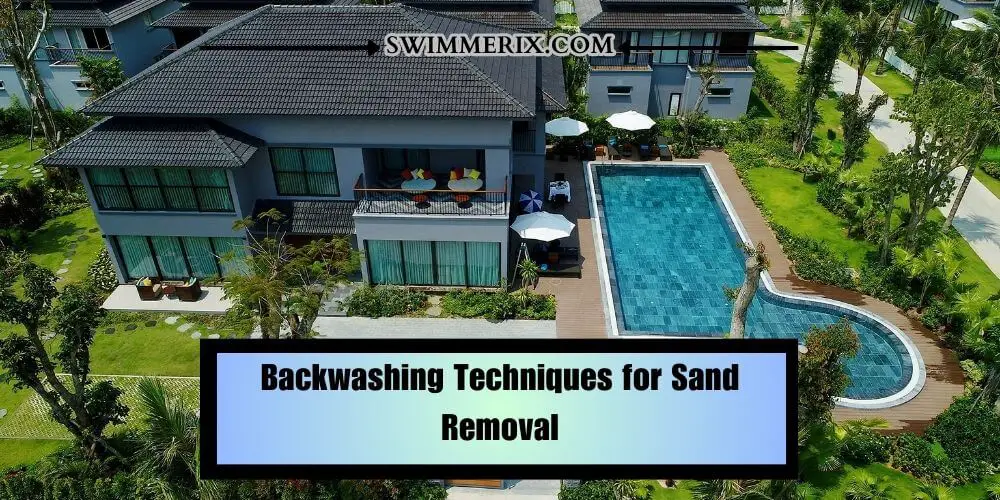
Undoubtedly, having a pool in your backyard is a wonderful luxury that offers a refreshing escape from the scorching heat during the summer. However, like any good thing, it will also come with its fair share of responsibilities & issues that you might encounter.
One common issue most pool owners face is finding ‘sand in the pool after backwash.’ This is kind of a pesky problem that tends to be frustrating but fear not. In this article, I will help you learn all the reasons behind the accumulation of sand in pools after backwash and cleaning tips that can help you maintain a crystal-clear pool.
But before I tell you the causes of sand in your pool, you must get familiar with that backwashing. If you already know what that backwashing is, let’s first understand the impact of sand in the pool after backwashing & then we will take a quick look at the common causes of this pesky issue.
Sand in Pool After Backwash (Causes)

Generally, sand filters are the major pool component to keep it clean & crystal clear. A sand filter usually works by trapping dirt & debris, further allowing clean water to pass through. Over time this filter may get clogged, reducing its efficiency.
When it comes to backwashing is the process of reversing the flow of water through the filter to flush out any trapped debris or dirt in it. We all understand how frustrating it can be to spot sand finding its way into your pool after backwashing.
If you want to know what is causing this issue, there are a few. The primary cause of this issue usually lies in the filter system itself. According to a study conducted by the national fool spa & Foundation, damaged filter components like broken laterals can lead to sand leakage during backwashing.
In addition, improper backwashing may contribute to sand accumulation in the pool after backwashing. According to the World Health Organization, you might not be backwashing for the appropriate duration. It is recommended to backwash for an extended time, depending on your filter type & pool size.
Yes, all; the duration for backwashing varies depending on the filter & pool size. So make sure you consult your pool manufacturer’s guidelines. Also, high filter pressure may exacerbate this kind of problem. When the pressure gauge shows excessively high pressure, it indicates that your filter is clogged & you need to backwash it.
It would be best never to ignore this, as it may lead to sand being forced back into the pool water. Hence, ensure you are performing regular backwashing with the correct technique and inspecting your filter system occasionally for any damages or malfunctioning to prevent sand in your pool. If left unattended, it may cause other issues. First, find out the sand’s impact on the pool after backwashing.
Impact of Sand in the Pool
Now that we understand the causes of sand accumulation let’s explore its impact on your pool’s water quality & filtration system.
Effect on Water Clarity & Quality
After doing hours & hours of research, I learned about the study conducted by Groupe Bellemare, revealing that the presence of sand in your pool can significantly affect its water quality and clarity.
You might already know that sand particles make the water look & uninviting and also lead to imbalances in the pool water chemical levels. When the sand is introduced into the pool water, it starts as a foreign contaminant, causing chemical reactions leading to increased chlorine consumption, making it unsafe for swimming.
This may also result in higher chemical costs & the need for more frequent water balance, including water shock treatment. In addition, sand accumulating in the pool will further create a breeding ground for bacterial pathogens and algae.
These microorganisms thrive in the presence of organic matter, which may be trapped within the sand particles. And, if you do not pay attention to it, you will bathe stubborn algae blooms more often in your pool.
Therefore, if you want to ensure your pool water remains sparkling & inviting, I will advise you to address sand accumulation promptly & maintain the optimal chemical levels in it for a safe & fun swimming experience.
Damage to the Filtration System
Apart from impacting the water quality & clarity, sand accumulation in the pool may also wreak havoc on your pool filtration system. As I told you earlier, any damaged filter component may contribute to sand leakage during backwashing.
In addition to this, if your filter is clogged with sand particles, it will further impede the water flow, reducing overall filtration & backwashing efficiency. A study that the Department of Energy (.gov) conducted reported that clogged filters would increase energy consumption as the pool pump will have to work harder to maintain the water circulation & clarity.
This increases your energy bill and puts unnecessary strain on the equipment, potentially hindering lifespan. In addition, prolonged neglect of a clogged filter may lead to pump failure in extreme cases, requiring costly repairs or replacement. Therefore, ensure you are addressing the sand accumulation as soon as possible for water clarity and the longevity of your pool equipment.
Preventive Measures
You might have already heard that an ounce of prevention is worth a pound of cure. If not, you should know that prevention is always better than cure. Firstly, avoid backwashing too often, and to know more, read “Can You Backwash a Pool Too Much” Also, pay attention to regular pool maintenance, which is the key to keeping the sand at bay & your pool water pristine. Below I mention some essential maintenance tasks that you should incorporate into your pool care routine.
Skimming & Cleaning Routines
I don’t know if you know this, but daily skimming & cleaning of your pool can go a long way in preventing debris from entering the filtration system.
Therefore, I will advise you to invest in a good quality skimmer that can further help you remove leaves, insects, as well as other debris from the water surface of your pool to keep it crystal clear. The less debris that makes its way into the filter, the lower the chances of sand accumulation.
Monitoring Filter Pressure & Cleaning Frequency
Apart from paying attention to daily skimming & cleaning of your pool, it would be best to keep a close eye on your filter pressure gauge to know when it’s time to backwash. According to a Pelican Bay Pools study, the optimal pressure range for most pool filters is between 8 to 10 PSI. When the pressure rises 25% above this range, it is time that you perform a proper backwash of your pool water.
Regular Filter Maintenance
Periodically, you should also inspect your pool components, like its filter system, for signs of any damage or wear & tear. Proactive maintenance can go a long way in helping you identify potential issues before they lead to sand leakage or filter clogging.
Incorporating all these maintenance practices into your pool care routine can significantly reduce the likelihood of sand accumulation in your pool after backwashing.
Backwashing Techniques for Sand Removal

If you are already facing the issue of sand in your pool after backwashing, don’t be so worried about it. You might not be feeling following the proper backwashing techniques required to remove the sand effectively and restore the water quality properly. Below is a step-by-step guide to effective backwashing & keep your water pristine.
- First, you need to turn off your pool pump to halt the water circulation & do a thorough inspection.
- If everything looks good, switch the multiport valve to the backwash position.
- Now, you can turn the pump back on & let it run for the recommended duration. I usually let it run for about 23 minutes or until the water in the side glass becomes clear.
- Once you have completed the backwashing properly, turn off the pump again & switch its valves to the rinse position.
- Finally, you can switch the valve to the filter position & you are good to go.
You should avoid backwashing too frequently as it may lead to water wastage. Therefore, ensure you follow the pool manufacturer’s guidelines for backwashing frequency based on your pool size & usage.
In addition, you can also consider using flocculants or clarifiers that work by coagulating fine particles, including sand & settling them to the bottom of the pool, making it easier for you to vacuum & remove the sand from the pool floor.
Seeking Professional Assistance
If you find it hard to resolve the sand accumulation in your pool, which is safe to be overwhelming for most pool owners, never hesitate to seek professional pool Maintenance services no matter how much it costs.
You should know that a certified pool technician is the best person to help you assess the situation better & use specialized equipment to remove sand efficiently, especially if you’re unsure about the best course of action. Professionals will also help you inspect your pool filter system & recommend any necessary repair or replacement that seems viable.
Conclusion
Dealing with sand in a pool after backwashing can be a frustrating experience. But if you are armed with the proper knowledge we have covered in the articles, you will be able to take preventive measures & tackle this issue more effectively.
I have given my best to give you all the information on the question: why is there sand in the pool after backwashing & what to do about it? Always remember to perform regular maintenance, use high-quality sand media, and follow proper backwashing techniques to minimize the accumulation of sand in your pool.
If sand does find its way into your pool, you should consider manual cleaning methods and professional pool Maintenance services to tackle the issue more effectively.
Undoubtedly, a clean & well-maintained pool provides refreshment during the hot summer months and ensures the longevity of your pool equipment & the enjoyment of your pool for years to come.
Check my other helpful guide on pool care & maintenance shared on this website. See you in the next post, till then, take care & goodbye.

